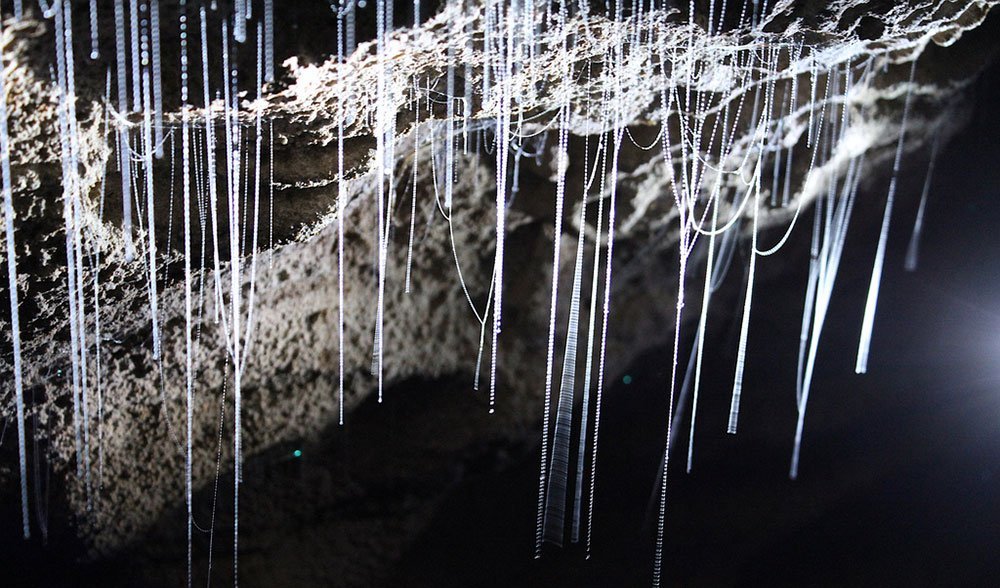Lighting the night: glow worms around Australia

AUSTRALIA IS HOME to eight recognised glow worm species, known for their spectacular bioluminescence or ‘living light’.
Despite their name, these luminous locals are not actually worms, but the larvae of a primitive fly – the fungus gnat – and they form a large component of the insects’ boom-and-bust life cycle. They can be found in dense rainforests of Gondwanan origin and caves or rocky structures, thriving in permanently wet habitats.
During the day they are inconspicuous, but in the darkness these luminescent larvae sparkle, dotting caves, tunnels and walkways with blue-green light.

The Lithgow Glowworm Tunnel. (Photo credit: Shannon Verhagen)
Bioluminescence – a predatory light
Adult fungus gnats have a short lifespan of just two to three days, during which time they mate and lay eggs before perishing. Once the eggs hatch, the larvae emerge to embark on the longest stage of their life cycle – around nine months. Adult gnats lack working mouthparts and are unable to eat, so during this time, the larvae must consume enough energy to metamorphose and survive the next breeding season.
Similar to spiders, they produce long, sticky threads to catch passing invertebrates such as mosquitoes and midges. However, it is another predatory tactic that has caught the world’s (and their preys’) attention. A chemical reaction between an enzyme and pigment in the larvae’s body with the oxygen in the air causes them to emit a blue-green light – visible through the transparent skin in their abdomen. This light lures prey closer, tricking them into becoming entangled in the larvae’s silken threads.

Glow worms create long, sticky threads to capture their prey. (Photo credit: Kristina D.C. Hoeppner / Flickr)
Visiting our glow worms
While beautiful, these animals are sensitive to changes in their environment. Dependant on permanently wet habitat, the country’s continuously drying climate has restricted Australia’s glow worm colonies to a handful of locations across the country. It is important when visiting these locations to ensure as little impact on the larvae as possible.
When visiting glow worms:
- Use your torch to shine on the ground only – do not shine it directly at the glow worms;
- Do not use flash photography – use a long exposure to capture their light;
- Do not smoke;
- Keep noise to a minimum;
- Do not touch them.
The most spectacular glow worm displays can be seen during the warmer, wetter months, from December to March, and can be found at the following locations.
Natural Bridge, Springbrook National Park, Gold Coast, QLD
This World Heritage Area – located about an hour south of the Gold Coast – is home to Australia’s largest colony of glow worms. On guided nocturnal tours, thousands can be seen lighting up the spectacular rock formation with blue-green light.
Glowworm Tunnel, Lithgow, Blue Mountains, NSW

Glow worm tunnel in Helensburgh. (Photo credit: Christian-Reusch/Flickr)
Located about 40km from Lithgow, this 400m tunnel stands tall, surrounded by lush rainforest. Originally built as part of the railway to Newnes Kerosene and Shale Works, it was dismantled in the 1940s, and the glow worms took to the dark, damp conditions it provided. Due to the tunnel’s length, the glow worms can be seen during the day towards the middle of the dark tunnel.
Glow Worm Glen, Bundanoon, Morton National Park, NSW
About two hours south-east of Sydney, the Southern Highlands is home to a colony of glow worms. The glen can be accessed by a steep walking track, which takes about 30 minutes one-way.
Melba Gully, Great Otway National Park, VIC
Known as the “Jewel of the Otways,” Melba Gully – about 2.5 hours south-west of Melbourne – is one of the wettest locations in Victoria and home to dense rainforest, providing ideal conditions for glow worms. At night, they can be seen glowing on the overhanging ledges and in the soil along the walking tracks.
Tamborine Mountain, Gold Coast, QLD
What makes this destination unique to the others around the country is that these caves were purpose-built to house a colony of introduced glow worms. At the moment, specialised equipment maintains the moist environment needed for their survival, and a breeding program of their prey items ensures they have enough food. However, in the future, it is hoped the colony will become self-sufficient. The caves are open from 10am to 4pm daily.
READ MORE:
- GALLERY: Bioluminescence ‘sea sparkles’ light Tassie waters
- The hidden Nullarbor caves
- Adventure: Underwater cave diving




